“We just gloss over the Declaration of Independence at our school. The words are just too hard for my 5th graders to understand.”
I’m sure you can imagine the look on my face. It was a mixture of shock and sadness.
The Declaration of Independence is more than a dusty old document. It’s a time capsule full of information about how early Americans were treated badly and taken for granted by King George III and England.
Teaching the Declaration is one of the highlights of my school year! It’s a document that was written in the midst of a turbulent time and helped to develop a new nation.
Thomas Jefferson took on the monumental task of crafting a document that listed the colonists’ justification for breaking away from the Mother Country.
The Second Continental Congress approved and signed this document after they had tried every manner of reconciliation with England but received nothing in return.
I always have fun teaching American history but the Declaration of Independence is certainly one of my very favorite topics. I sincerely hope that you gain some new ideas and teaching strategies that will help you to bring this document to life in your classroom!
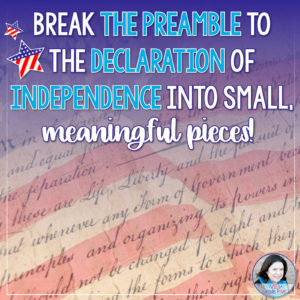
Break the Preamble into small, meaningful pieces!
The Preamble to the Declaration of Independence explains why the document was written. It is also the most recognizable part of the document.
If you present the entire preamble to students at once, they are undoubtedly going to feel overwhelmed.
To make my students feel successful with the Preamble, I create a chart with them and we discuss the meaning of each phrase, one at a time. We use interactive notebooks, so we created a chart together in our notebooks. However, this would also make an amazing anchor chart.
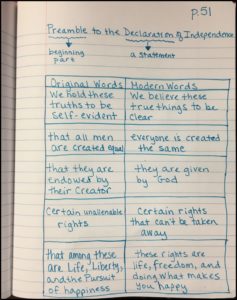
I do point out to my 5th graders that the phrase, “All men are created equal,” meant something different to our founding fathers than it means to us.
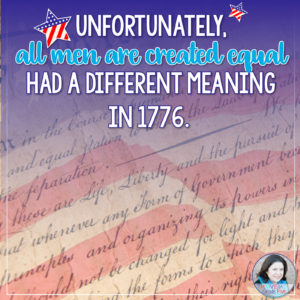
I emphasize that TODAY, we interpret this phrase as everyone, all men and women, are created equal, no matter their race, religion, etc.
Our founding fathers had a very narrow view of “All men.” Their interpretation of this phrase was “All free, white men who owned property.”
African Americans, women, Native Americans, indentured servants, poor white men, no one else was included.
I do point out the irony of this document. While complaining that they are not being treated fairly, many of the men who signed this document owned slaves. It creates quite a class discussion.
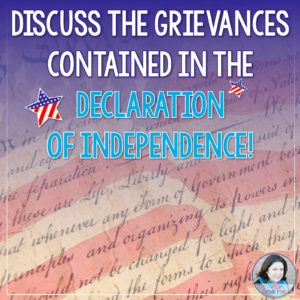
Discuss the grievances contained in the Declaration of Independence
A “grievance” is a complaint and the colonists certainly had a plethora of complaints against Mother England.
In fact, the majority of the Declaration of Independence contained complaints. Remember, this document was a justification to the world of why the colonists had every right to sever ties with England.
When discussing grievances with my 5th graders, I choose the ones that will make the most connections to their lives and/or what we’ve learned about so far in the year.
There are some grievances with complicated meanings, so I only choose a few to discuss with students.
In my opinion, 5th graders need a firm understanding of a few of the important grievances to help them grasp the meaning of the entire document.
Create this chart with your students to help them learn about some of the grievances and see the connections between what happened in colonial days and why each grievance was included.
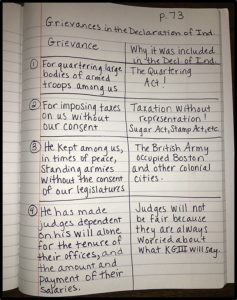
One more thing… to make the word “grievance” an everyday word, I start to use the word myself. If you’ve worked with 5th graders at all, you know that they have complaints about various things from time to time, or maybe all the time, depending on the mix of personalities in your classroom.
I just throw the word “grievance” in there when helping students to resolve their issues. “Rebecca, Jake has a grievance against you. He says you took the lead from his mechanical pencil without asking. How will we resolve this grievance?”
Yes, they’ll look at you like you have two heads, at first, but then they’ll start using the word themselves. The best way for students to learn new vocabulary is by integrating their word into their everyday language.

Show a music video
Seriously, guys, this short music video is a treasure. I get goose bumps when I watch it. “Too Late to Apologize” is a song parody that features Thomas Jefferson singing about the Declaration of Independence and the reasons he wrote it.
I show this video the first time and stop every little bit to explain things, like why they make King George III look so “yucky.” I point out the stamp from the Stamp Act. We try to guess which founding father each guy is portraying.
For example, Sam Adams is the one with the beer mug because his family owned a brewery.
Then, I show the video the second time all the way through without stopping.
Students will beg me to watch this video every day for the rest of the year. We do watch it many more times because I love it and it does a good job reinforcing the strong feelings of our founding fathers.
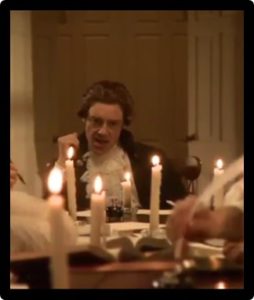
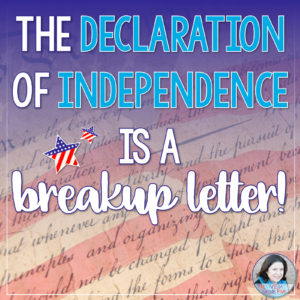
The Declaration of Independence is a break-up letter!
I have yet to meet a 5th grade class that doesn’t love a bit of drama. I will admit it… I have more fun with this activity than a teacher probably should! However, I can promise that you will have all eyes and ears when you share this pretend break-up letter with your class!
After discussing the parts of the Declaration, I start the next class with the break-up letter. I use the text on the letter below. However, I write out the letter on a sheet of notebook paper and crumple it to make it look like a student-written note.
In an irritated manner, I inform the class that I found a note on the floor and I don’t appreciate students passing notes in my class…blah…blah. I tell them that since I’m tired of them writing notes, I’m going to start reading them aloud, starting with the one I found.
When I read the note aloud, a hush falls over the room and students hang on every word. They are trying to figure out which of their classmates authored the note and to whom.
After reading the letter, I pretend I’ve had an epiphany… this note reminds me of the Declaration of Independence! I launch into a review of the parts of the Declaration. I always have 100% of my students’ attention.
Some years I will admit that it’s a fake note and other years, I never fess up. Have fun!
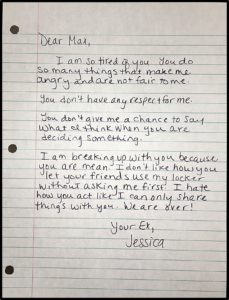
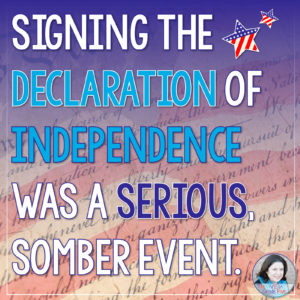
Signing the Declaration of Independence was a serious, somber event.
The signers of the Declaration didn’t wake up and say, “Yippee, I get to sign the Declaration of Independence today!”
Students need to understand that the decision to sign the Declaration was gut-wrenching and difficult. These were the most wealthy, powerful men in the colonies. They had a lot to lose if the colonies were defeated in their attempt at Revolution.
Signing the Declaration was treason and the men who signed it would be hunted and executed by England if the Revolution was lost.
While discussing this truth with students, I introduce them to Ben Franklin’s famous quote, “We must, indeed, all hang together or, most assuredly, we shall all hang separately.”
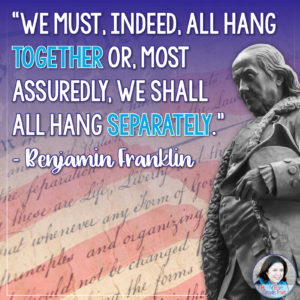
This makes a great journal entry in which students are asked to explain what Ben Franklin meant by this quote and why it was important for the leaders of the colonies to stick together during the American Revolution.
Show some pictures!
The Declaration of Independence is stored and protected in the National Archives Museum in Washington D.C., specifically in the Rotunda for the Charters of Freedom. Show students a picture of where the Declaration is kept. Talk about the armed guards and the thick glass that protects one of our most precious documents.

I also like to show my students a picture of Independence Hall in Philadelphia. We talk about how hot it was during the summer when the Second Continental Congress met and the Declaration of Independence was signed. There is a plethora of information and pictures on the site linked below. Just click on the image of Independence Hall.

Use Books
After teaching students the basics of the Declaration of Independence, I break them into small groups and ask them to look through the following book together. This book puts the Preamble and many of the grievances into modern language. I usually use groups of 3-4 per book. There are many amazing books that teach the Declaration of Independence, so look around and find a great resource for your students!
* Please note that Thrive in Grade Five (Jenifer Bazzit) is a participant in the Amazon Services LLC Associates Program, an affiliate advertising program designed to provide a means for sites to earn advertising fees by advertising and linking to amazon.com. *
These resources from my Teachers Pay Teachers store are very helpful in teaching the Declaration of Independence. If you are interested, click on the images to view the resources in my store!

Would you like a set of American Revolution Cloze Passages sent to you for free? Enter your first name and email address below to receive this freebie right away!
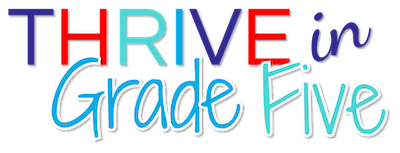

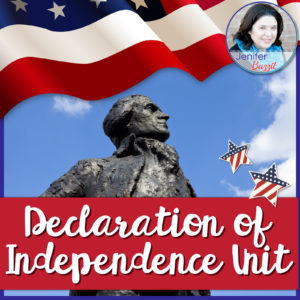
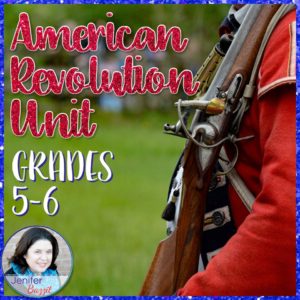



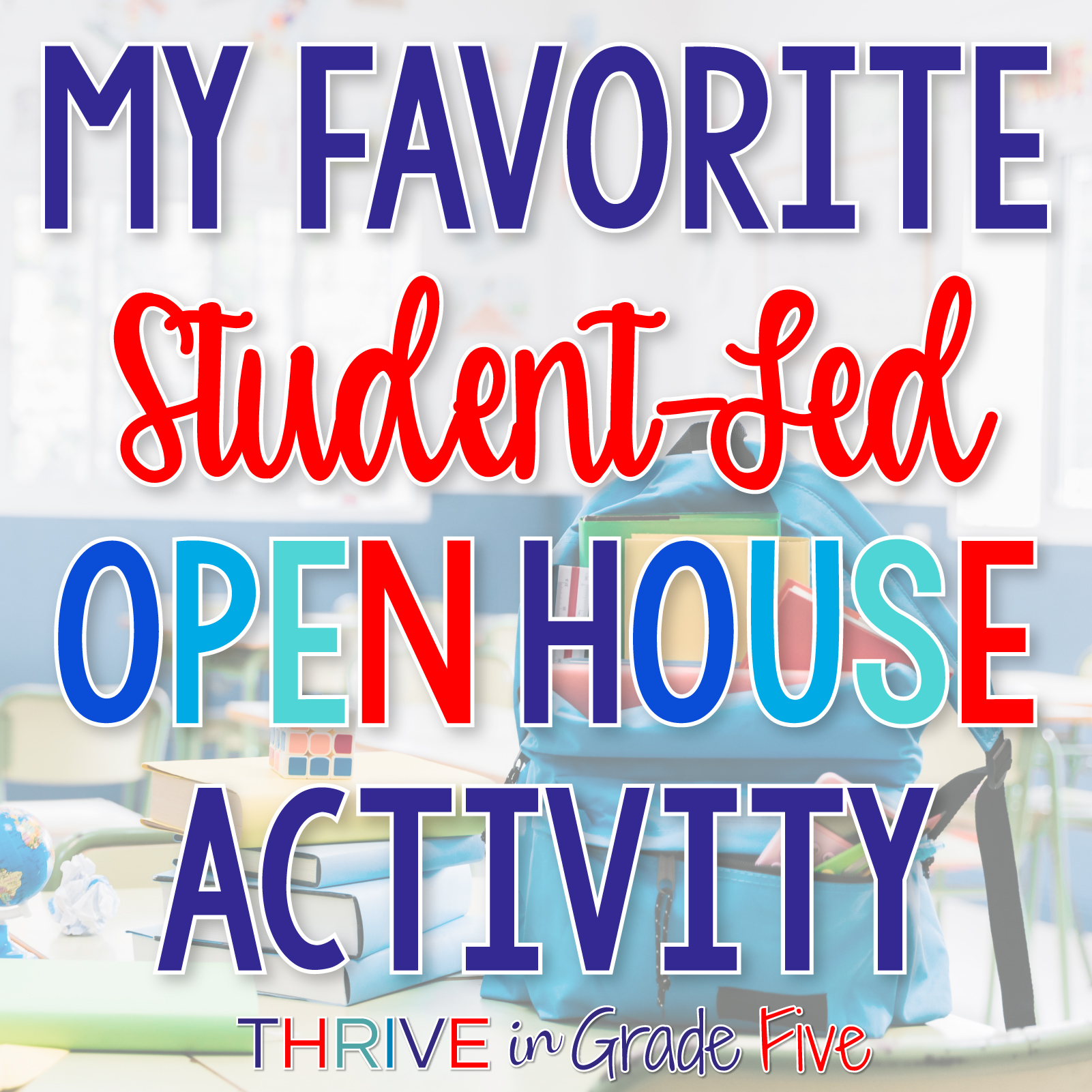


26 Comments
This whole thing was absolutely adorable and I can see how the kiddos would be hooked from start to finish. I love the breakdown of the Preamble and how you really make it accessable and understandable for kids their age.
Thank you so much, Stacey! I appreciate your feedback!
Thank you, thank you, thank you!! Every single thing on this site is amazing! My kids are so engaged and really into everything!
You are so welcome, Samantha! Thank you for taking them time to leave feedback!
Jenifer, thank you for this post! It was very helpful! I was wondering though, which book you use? I see you mention you use one but the title isn’t mentioned? Thank you!!
Hi Sarah! There should have been a link there. I’m sorry it didn’t show up!
Here’s the link to the book I use:
https://www.amazon.com/Declaration-Independence-Translation-Really-Translations/dp/1515762505/ref=as_sl_pc_qf_sp_asin_til?tag=jeniferbazzit-20&linkCode=w00&linkId=b570ffab6305f695b272f7d09343cbef&creativeASIN=1515762505
I discovered this song last year. My kids love it. I also use several other parody songs for the Boston tea party. Music is a great tool to use.
Absolutely, Kim! Music is a fantastic addition to any lesson!
Which unit in your TPT has the preamble and all of this btw?
Hi Sandy! My Declaration of Independence Unit would be what you are looking for:
https://www.teacherspayteachers.com/Product/Declaration-of-Independence-Unit-1028068
Wow , this is amazing, I have been looking everywhere for a working interesting lesson plan for my 8th graders. I must have spend almost 20 dollars in teacehrspayteacher.com but still could not find something suited to me. This was just amazing . I loved it. I changed some for my 8th grade. and it looks awesome , i will be doing it this weekend.
I’m so glad to hear that!
I’ve been looking for nice activities to make my ESL students interested on the 4th of July and this is definitely what I wanted. Thank you so much, Jennifer! You must be an awesome teacher
Oh, thank you so much, Kendy! I try to be the best teacher I can. I’m sure you are an amazing teacher too 🙂
Love! Love! Love! the break up letter and interactive notes! This is fantastic!Will be using tomorrow!
That’s great, Jennifer! I’m so glad you liked that!
This is really generous of you to share this! It is absolutely perfect for my class and I can’t wait to use your ideas! Thanks again and I wish you all the best!
~Miriam, 5th grade, Seattle
You are very welcome, Miriam! Thank you for taking the time to leave a comment 🙂
This is a great resource! When I teach the DOI I emphasize that the Founding Fathers didn’t mean all mankind is created the same but rather all are equal in value or human dignity. Then I talk about how they were already beginning an ongoing struggle with the contradiction and dilemma of the existance of slavery in the colonies and the fact that slavery doesn’t recognize that dignity.
Thank you, Carrie!
I am a US-raised Mom living overseas, and give my kids US history “classes” as I think it is important that they learn about this part of their heritage. Thank you for this lesson. They loved it – – the “break up letter” approach was a huge hit, as was the video. If you have more lesson materials that could be of help to a US history homeschool Mom like me, I would be interested in being in touch. I have looked a lot on the web and haven’t had much luck finding engaging and easy-to-implement ideas. Thank you for this!
You are so welcome, Karen! I am so glad you enjoyed this post and found it helpful 🙂
The video song is amazing!! I can’t wait to show it to my kids!! Thank you for the freebie!!
So glad you like it, Sophia! This song is definitely one of my favorites 🙂
This is super helpful, also for my older ESL students. Thank you for sharing these great ideas!
You are very welcome, Henriette! Thank you for taking the time to leave a comment 🙂